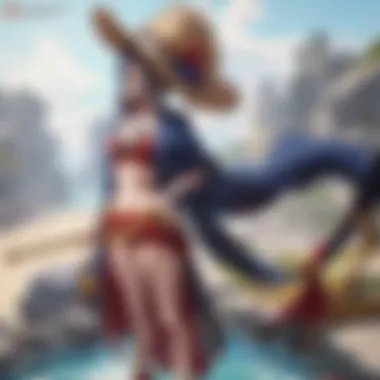Exploring the Depths of One Piece: Season Analysis


Intro
One Piece is more than just an anime or manga series; it's a cultural phenomenon that has shaped the landscape of storytelling in these mediums. Created by Eiichiro Oda, it artfully combines adventure, humor, and profound themes into a coherent narrative that spans over two decades. With numerous seasons filled with rich storytelling and character developments, One Piece offers a treasure trove of content for both newcomers and seasoned fans. This comprehensive examination will delve into each full season, dissecting their crucial narrative arcs, character evolutions, and the cultural impact they have garnered.
Featured Series or Manga
Overview of the Series
One Piece first premiered in 1997 as a manga and later evolved into an equally popular anime series. The story follows Monkey D. Luffy and his crew, the Straw Hat Pirates, as they sail across the Grand Line in search of the ultimate treasure known as "One Piece." Each season introduces new islands, characters, and challenges, contributing to an ever-expanding world. The narrative is known for its intricate world-building and layered character developments, making it captivating to a broad audience.
Key Characters and Development
Luffy is the central character, but a plethora of compelling characters enrich the narrative. Key figures include:
- Roronoa Zoro: An aspiring swordsman who aims to become the world's strongest.
- Nami: The resourceful navigator determined to map the entire world.
- Sanji: The skilled cook with dreams of finding the All Blue.
- Robin: An archaeologist seeking the true history of the world.
Each character embarks on personal journeys that intertwine with the overarching plot, showcasing growth and change as they face adversities.
Character Analysis
Major Characters
The major characters in One Piece serve as the backbone of the series. With complex personalities and backstories, they create an emotional connection with the audience. Each character represents different ideals and ambitions, adding depth to the story. The relationships among the crew also emphasize themes of friendship, loyalty, and perseverance.
Character Arcs and Growth
Character arcs in One Piece are vital for understanding the broader narrative. For instance, Zoro's commitment to honor and strength challenges him physically and emotionally throughout various arcs. Meanwhile, Nami's journey from a thief to a respected member of the crew showcases transformation and resilience. The evolution of these characters is carefully plotted, often reflecting the series’ themes of dreams and ambitions.
Thematic Exploration
Main Themes and Messages
One Piece explores themes such as freedom, friendship, and the pursuit of dreams. The characters' quests for their personal goals often mirror the larger struggle for freedom in a world filled with oppression. Central messages include the importance of believing in oneself and the value of camaraderie, which resonate deeply with viewers and readers alike.
Cultural Context and Influences
Eiichiro Oda draws inspiration from various cultures and historical references, from pirates and folklore to real-world issues. This amalgamation enriches the series and allows for deeper analysis. The cultural significance of One Piece extends beyond Japan, impacting global anime and manga communities and inspiring countless artists and creators.
"One Piece is a journey through the complexities of human ambition, wrapped in adventure and camaraderie."
By closely examining the full seasons of One Piece, the article aims to highlight its narrative complexities while providing insights into character developments and thematic depth.
Prologue to One Piece
The significance of "One Piece" in the realms of anime and manga cannot be overstated. As one of the longest-running and most successful series, it has shaped the industry and inspired countless works. This article delves into the structure and narratives of the series, enriching both understanding and appreciation. By exploring the vast world of One Piece, readers can better grasp its appeal, insights, and the complexities of its characters and stories.
Origins of the Series
"One Piece" began serialization in Shueisha's Weekly Shōnen Jump in July 1997. Created by Eiichiro Oda, the series was inspired by his childhood dreams of adventure and exploration. From the beggining, Oda envisioned a grand storyline, filled with rich characters and a detailed world. The title itself refers to the ultimate treasure that protagonist Monkey D. Luffy seeks, symbolizing freedom and the pursuit of dreams.
The serialization quickly gathered a devoted following, leading to its adaptation into anime by Toei Animation in 1999. This marked the start of a cultural phenomenon that would encapsulate generations of fans. The series reflects a significant evolution in storytelling techniques within manga and anime, setting new standards for character development and thematic depth.
Overview of the Concept
At its core, "One Piece" is a tale of adventure, friendship, and the quest for dreams. The narrative follows the journey of Monkey D. Luffy and his diverse crew of pirates known as the Straw Hat Pirates. Each member of the crew has individual backstories, motivations, and aspirations, making the cast vibrant and relatable.


The series is structured around seasons, with each season focusing on certain arcs that unfold the greater narrative. Key themes include loyalty, freedom, and the moral ambiguity of justice. It challenges traditional notions of heroism, presenting morally complex characters that resonate with a wide audience.
"One Piece combines humor, action, and heartfelt moments, making it an enduring staple in the anime and manga landscape."
Through this examination of the full seasons, readers will uncover the layers of complexity embedded in "One Piece," appreciating how it transcends the genre and connects with themes that are universally human. The narrative is not just about pirate adventures; it reflects social issues, personal growth, and the bonds forged through shared experiences.
The Structural Composition of One Piece
The narrative framework of One Piece is pivotal to its success. This section explores the structural composition of the series. Understanding this makes the viewing experience richer. The divisions into full seasons and arcs contribute to the storytelling. Each part serves a purpose in character progression and plot advancement.
Defining Full Seasons
Full seasons in One Piece are more than mere collections of episodes. They encapsulate distinct narrative arcs that connect to a larger theme. Each season has a unique central story that propels the plot forward. The distinct seasons allow viewers to follow the journey of Luffy and his crew easily.
Seasons are typically tied to geographical locations or significant events. For example, the "East Blue Saga" introduces Luffy and key crew members. It sets the tone for future adventures. This structure also helps in pacing the story, ensuring that it unfolds in a captivating manner.
Top reasons for the importance of full seasons:
- Cohesive Storytelling: Each season has an identifiable beginning, middle, and end.
- Character Development: Characters have room to grow throughout the season arcs.
- Evolving Themes: Major themes often emerge within each season, adding layers to the narrative.
Arc Segmentation
Arc segmentation divides the story into smaller, manageable parts. Each arc presents new challenges and villains that the characters must confront. This segmentation maintains engagement by offering fresh experiences regularly.
For instance, the "Alabasta Saga" focuses on the struggle against Crocodile. It deepens the mythology around the world of One Piece. Understanding arc segmentation helps fans appreciate the intricacies of the story.
Key aspects of arc segmentation include:
- Character Focus: Different arcs spotlight various crew members.
- Story Progression: Each arc builds on the previous one, leading to meaningful resolutions.
- Variety of Conflicts: Arcs introduce different conflicts, enriching the narrative fabric.
"The segmented arcs in One Piece allow the story to expand without losing coherence."
In summary, the structural design of One Piece plays a significant role in its storytelling. Full seasons and arc segmentation ensure that the narrative remains structured yet flexible. This design accommodates character growth while maintaining a captivating storyline.
Exploring Key Seasons
The exploration of key seasons in One Piece is vital for understanding the series' overall narrative structure and character progression. Each season is not just a mere division of episodes but a carefully crafted arc that enhances the thematic richness of the series. By delving into these seasons, one gains insight into the evolving dynamics of the characters, their motivations, and how they react to the challenges posed by their world. Moreover, each season often introduces new elements that keep the content fresh and engaging.
Understanding these key seasons provides readers with a framework for analyzing the rise of significant figures like Monkey D. Luffy, the Straw Hat Pirates, and many formidable antagonists they encounter. Noticeable transformations in relationships among the Straw Hat crew are particularly significant. This narrative progression allows fans to develop a deeper connection to the characters, making the journey more impactful.
Season One: East Blue Saga
The East Blue Saga serves as the introduction to the One Piece universe. It sets the stage both literally and thematically, where the Straw Hat crew embarks on their first adventure. This season captures Luffy's dream of becoming Pirate King and assembles his initial crew members, including Zoro, Nami, Usopp, and Sanji. Each character's introduction is critical as it showcases their unique backstories, aspirations, and contributions to the crew.
The season also establishes key themes, such as friendship and dreams, which recur throughout the series. The fight against the pirate Alvida, as well as captains like Buggy and Kuro, lays a foundation of Luffy's determination and introduces viewers to the series' blend of humor, action, and emotional moments.
Season Two: Alabasta Saga
In contrast to the East Blue Saga, the Alabasta Saga presents a more complex storyline that involves political intrigue and rebellion. Here, Luffy and his crew travel to the Grand Line. The introduction of Nico Robin and their confrontation against the powerful Baroque Works adds layers to character interactions. The stakes rise dramatically in this saga as the crew faces a significant antagonist in Crocodile, whose nefarious plans threaten the very stability of the kingdom of Alabasta.
This season highlights the theme of sacrifice deeply, as the crew must band together to protect those they care for. It illustrates Luffy's growth as a captain, capable of inspiring those around him to fight for their beliefs.
Season Three: Sky Island Saga
The Sky Island Saga transports the crew to the clouds, introducing the mystical Skypiea and its complex lore. This season not only continues the adventures of the Straw Hats but delves into mythology and the concept of freedom, which is central to One Piece. The conflict with Enel serves as a metaphor for tyranny versus freedom, making it a thought-provoking addition to the series.
The crew interacts with diverse inhabitants and deals with moral dilemmas, which shows their development as characters. The bonds between the crew grow stronger as they navigate through new challenges that test their resolve.
Season Four: Water Seven Saga


The Water Seven Saga is pivotal in the development of both the plot and character arcs. The introduction of Franky and the shocking betrayal by Nico Robin create tension within the crew. Water Seven showcases intricate relationships amid external conflicts with CP9, a secret government organization. The stark contrast between trust and betrayal becomes evident during this saga.
It emphasizes the importance of teamwork and loyalty, culminating in emotional moments that resonate with viewers. The saga also highlights Luffy's determination to protect his crew, thus elevating the stakes for the narrative.
Season Five: Thriller Bark Saga
The Thriller Bark Saga is primarily known for its supernatural themes and introduces the terrifying world of zombies. This season showcases a darker tone, where the crew faces off against Gecko Moria and his army of undead. The theme of loss becomes apparent, as Brook's introduction brings a sense of mortality, especially with his backstory focusing on the loss of his crew.
This saga illustrates how Luffy and the Straw Hats adapt and respond to despair while fostering resilience. It also marks a turning point for character dynamics as they confront fears and develop new strategies to overcome challenges.
Season Six: Summit War Saga
The Summit War Saga fundamentally reshapes the series' direction. This arc contains intense battles and monumental stakes, especially during the Marineford War. Key characters like Whitebeard come to the forefront, influencing the battlefield’s politics and power dynamics. The complexity of justice, morality, and sacrifice becomes evident amidst the chaos of war.
Through this arc, viewers see Luffy transform dramatically, particularly as he grapples with loss and embarks on a path of self-discovery. The emotional weight of this saga resonates deeply within the broader narrative.
Season Seven: Fish-Man Island Saga
The Fish-Man Island Saga marks the return of the Straw Hats after a two-year time skip. This season emphasizes themes of racism and acceptance as Luffy and his crew encounter the Fish-Man community and confront the prejudices that exist within their world. The saga's main antagonist, Hody Jones, serves as a foil to Luffy's ideals, highlighting the ongoing struggle for coexistence.
Central to this saga is the growth of each crew member as they deal with their past experiences. The theme of overcoming adversity is prevalent, adding depth to their character arcs as they evolve both individually and collectively.
Season Eight: Dressrosa Saga
The Dressrosa Saga is an intricate tapestry of interpersonal relationships and societal issues. The introduction of Doflamingo adds complexity to antagonistic elements, as his character embodies chaos and manipulation. The unfolding battles in Dressrosa emphasize the fight against oppression and the power of unity.
As Luffy joins forces with local allies, this season solidifies the emphasis on friendship and collaboration, illustrating the importance of rallying together against tyranny. It culminates in emotional and action-packed climax that defines the crew’s resolve.
Through each season, One Piece illustrates not just adventure but a deeper exploration of human emotions, societal issues, and the pursuit of dreams. This comprehensive examination of the key seasons provides the viewer with a better understanding of the series' robustness and enduring appeal.
Character Development Across Seasons
The exploration of character development across seasons in One Piece is crucial for understanding the series' narrative depth. This manga and anime does not merely follow a linear plot; it creates complex characters who evolve significantly over time. This evolution contributes to the emotional weight and thematic complexity of the show, resonating deeply with viewers. Character development also serves to mirror real-life experiences of growth, making the story relatable to a broad audience.
Luffy's Evolution
Monkey D. Luffy, the protagonist, showcases remarkable evolution throughout the series. His journey is marked by a relentless pursuit of freedom and the aspiration to become the king of pirates. Each season adds layers to his character. In the early episodes, Luffy appears naive but fiercely loyal to his friends. As the arcs progress, we witness a profound transformation.
In the Water Seven saga, Luffy faces significant challenges which test his leadership and resolve. His reaction to the disarray within his crew during these times reflects a maturation in his understanding of camaraderie and responsibility. He learns the importance of bearing burdens for his friends.
The Straw Hat Crew Dynamics
The dynamic between the Straw Hat crew members also exemplifies character development. Each member brings unique personality traits and backgrounds that contribute to the group’s overall cohesion. For instance, Nami’s growth from a thief focused on self-interest to a dedicated navigator for the crew underscores the change in her values as she associates closely with Luffy and others.
Throughout the various seasons, conflicts and resolutions among crew members deepen their relationships. Their interactions illustrate diverse themes such as trust and friendship, each character pushing the others towards growth. The ensemble cast has enabled One Piece to explore various forms of interpersonal dynamics, enriching the storytelling.
Antagonists and Their Depth
Antagonists in One Piece are not mere obstacles; they often embody deep personal struggles that parallel the protagonists’ journeys. Characters like Crocodile and Rob Lucci offer more than opposition; they present philosophical challenges and reflect the darker sides of ambition and power. Their backstories frequently reveal motivations that resonate with Luffy's ideals, adding emotional complexity.
This depth in antagonistic characters reveals that conflict in One Piece goes beyond surface-level battles. The encounters often lead to moments of reflection and growth for the protagonists, making these engagements essential to their development.
"In One Piece, every character, even those on opposing sides, contributes to the growth and revelations experienced along the journey."
Overall, character development is one of the core aspects that make One Piece compelling. It intertwines growth with adventure, building a narrative tapestry that engages audiences deeply. The evolution of characters like Luffy, the dynamic within the Straw Hat crew, and the depth of the antagonists create a multi-layered storytelling experience that resonates with fans worldwide.


Themes and Philosophies
The themes and philosophies in One Piece are central to its narrative structure and depth. Throughout the series, these themes resonate with both character development and plot progression. They reflect not only the individual journeys of characters but the broader implications that mirror real-world beliefs and societal norms. Understanding these themes enriches the viewer's experience, allowing them to connect more profoundly with the storyline and its characters.
Friendship and Bonds
Friendship serves as a cornerstone of One Piece’s narrative. The bond amongst the Straw Hat crew illustrates a powerful message: the strength derived from unity. Monkey D. Luffy, the captain, personifies this theme by forming bonds with various individuals, often in the face of adversity. The crew's unwavering commitment to one another highlights the importance of loyalty and support.
Additionally, friendships in the series extend beyond the crew itself. Characters like Tony Tony Chopper and Nico Robin showcase personal growth through their relationships. These connections often act as catalysts for character development, enriching the story's emotional depth.
"True friendship is a journey without an end."
This quote encapsulates the essence of camaraderie found throughout the series, emphasizing that relationships evolve as the narrative unfolds.
Freedom and Adventure
Freedom, a prominent theme within One Piece, resonates deeply with the protagonist’s quest to become the Pirate King. Luffy's journey is not merely about achieving a title; it represents the pursuit of freedom – freedom to explore, to dream, and to defy constraints imposed by society. The series regularly contrasts the ideals of freedom against the harsh reality presented by authority figures, such as the Marines and World Government.
Moreover, the adventure aspect of the series complements this theme. The vast oceans, diverse islands, and unique cultures encountered along the way reflect the endless possibilities of exploration. Characters face challenges that require them to choose between personal desires and the freedom of others. This ongoing struggle highlights the complexity of freedom, urging the audience to contemplate its true meaning.
Justice and Morality
Justice and morality in One Piece are intricately woven into the storyline. The series often presents moral dilemmas, challenging characters to make difficult decisions. The definition of justice varies among characters, revealing personal motivations and the impact of their past experiences. Figures like Portgas D. Ace and Monkey D. Garp reveal differing views on what it means to deliver justice.
Furthermore, the series emphasizes the concept of moral ambiguity; not all actions are black and white. Characters often operate in gray areas, where the right choice is not always clear. This complexity adds depth to the narrative and prompts viewers to consider their own moral beliefs.
Cultural Impact of One Piece
The cultural impact of One Piece extends far beyond its narrative realm. This series is not merely a collection of animated episodes; it is a phenomenon that has shaped the anime and manga industries. One Piece has influenced generations, inciting countless discussions on themes of adventure, friendship, and ambition while setting benchmarks in storytelling and character development. The show's significance can be examined through various lenses, including its global popularity and its robust merchandising strategies.
Global Popularity
One Piece enjoys a monumental global presence, making it one of the most successful manga and anime series in history. Launched in 1997, it has grown to captivate millions. According to recent estimates, One Piece has surpassed 480 million copies in print worldwide. This extensive reach highlights the series’ ability to connect with diverse audiences across different cultures.
The adaptations into anime have also played a crucial role in enhancing this popularity. The anime, which began airing in 1999, continued to draw in new viewers, establishing a dedicated fanbase over the years. Fans engage deeply with the content, following its complex stories and well-crafted characters.
Additionally, the series has sparked a rich online community. Social media platforms such as Reddit and Facebook serve as hubs for discussions and fan theories, further solidifying its cultural status. The relevance of One Piece to modern narratives in other cultures is apparent, inspiring a plethora of creators.
"One Piece is more than a series; it is a cultural movement that transcends boundaries, uniting fans from all walks of life."
Merchandising and Adaptations
The merchandising of One Piece has significantly contributed to its durability in popular culture. Products range from action figures and clothing to collectibles and video games. Companies like Bandai and Funimation have capitalized on this success. The unique appeal of its characters has made them ideal for merchandising, attracting both avid anime followers and casual consumers.
Adaptations like movies and video games have also played a crucial role in extending the franchise's reach. Numerous films, including One Piece: Stampede and One Piece Film: Z, have garnered significant box office success. These films are often an extension of existing storylines or introduce original plots that resonate with both longtime fans and newcomers.
Moreover, the success of live-action adaptations has been explored with upcoming projects aiming to broaden the audience even further. Each adaptation keeps the essence of what makes One Piece unique while appealing to different audience segments. This adaptability showcases the series' timeless relevance while securing its legacy.
In summary, the cultural impact of One Piece is multifaceted, demonstrating a profound global appeal and a highly successful merchandising strategy that continues to thrive. It is a series firmly rooted in the fabric of modern anime and manga, offering valuable insights into the cultural significance of storytelling.
Finale
The conclusion serves as a critical summation of themes and explorations discussed regarding One Piece and its full seasons. Reflecting on the journey, it emphasizes the importance of understanding the intricate layers that contribute to the success of the series.
The Enduring Legacy of One Piece
One Piece has transcended the boundaries of traditional storytelling. Its unique blend of adventure, character development, and moral complexities resonated with audiences in Japan and worldwide. Fans appreciate the series not merely as entertainment but as a significant cultural phenomenon.
The analysis of its full seasons reveals how they build upon each other, offering deeper insights into various themes such as friendship, freedom, and justice. Each saga contributes to a broader narrative framework, intertwining characters' growth with engaging plot developments. This layered structure not only captivates the viewers but also nurtures lasting connections with the characters and their journeys.
"One Piece is not just an anime; it is an exploration of human emotions and relationships set against the backdrop of a fantastical world."
Key Elements of Its Legacy
- Cultural Significance: One Piece has shaped the anime landscape, influencing countless series and fostering a rich community of fans.
- Merchandising: The series' expansive universe has allowed for diverse merchandising opportunities, further embedding it into global culture.
- Adaptations: Various adaptations, including films, video games, and recently live-action series, continue to expand its reach.
In summary, the conclusion emphasizes the significance of One Piece as a transformative narrative. Its unique storytelling approach impacts not only its audience but also the broader landscape of anime and manga, solidifying its place in popular culture.



